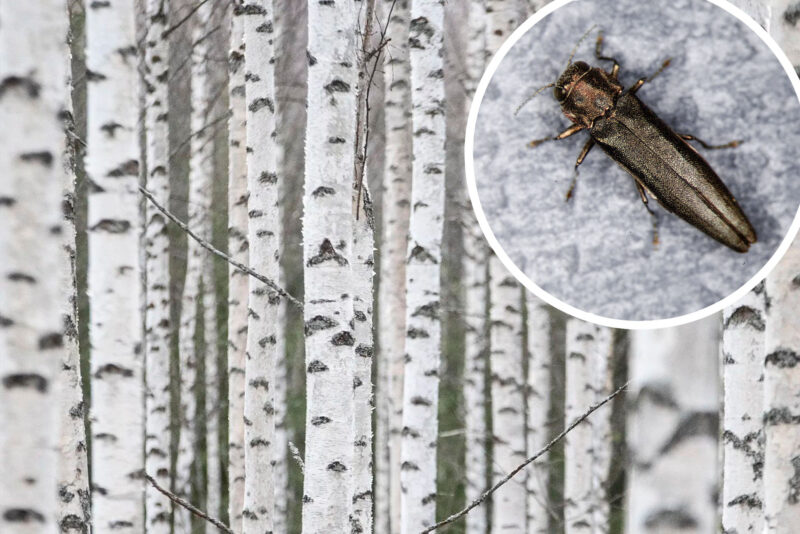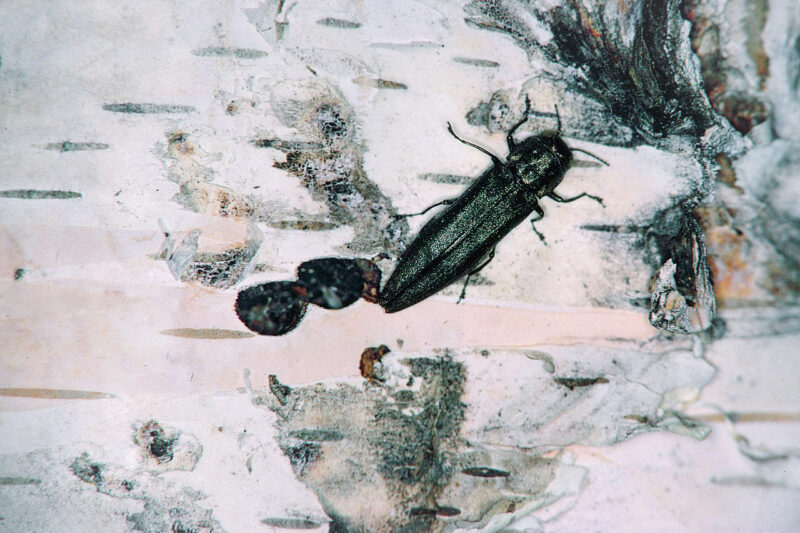Study: Bronze birch borer could kill all European birches – Chilling experience: ’Even total destruction seen’

If the bronze birch borer beetle was to spread to Europe, this would be close to a death sentence to birches, warns a bulletin by the Swedish University of Agricultural Sciences. Finnish expert Heikki Nuorteva of Natural Resources Institute Finland is less alarmed.
- If the bronze birch borer beetle spreads, the Swedish University of Agricultural Sciences warns that a repetition of experience in North America could mean the almost total destruction of European birches..
- So far, the pest has not been sighted in Europe, but a DNA-based method to identify it has been developed in Sweden.
- Combating the pest requires timely action and international cooperation.
‘Based on observations of European birch planted in North America, we can expect nearly 100% mortality of European birch,’ says PhD student Sezer Olivia Kaya in a bulletin of the Swedish University of Agricultural Sciences (SLU).
So far, the deadly bronze birch borer (Agrilus anxius) has not been spotted in Europe, but it is being closely monitored.
Swedish researchers have developed a method based on molecular technology which can identify the bronze birch borer or its excrement even at an early stage, on the basis of DNA. The test, based on loop-mediated isotermic amplification (LAMP), was developed in Canada.
The beetle has already caused significant damage in North America. SLU researcher Michelle Cleary writes in the bulletin that a timely identification of the threat is important.
’Because insect pests do not know national borders, it is important to work together in the international plant protection community,’ says Cleary.
Could the bronze birch borer kill off birches in Europe, we ask Heikki Nuorteva, Senior Specialist at Natural Resources institute Finland (Luke).
’I personally don’t believe that every single birch in Europe would die because of an eventual infestation of the bronze birch borer here – or at least, that this would be sudden and total,’ says Nuorteva.
Despite this, Nuorteva does continue that the European silver birches planted in North America have been extremely susceptible to damage from bronze birch borers.
’If the bronze birch borer was to land in Europe, it would be crucially important to take measures that are as effective and rapid as possible, to prevent any possibility of it spreading into the environment. There’s no point in taking unnecessary risks,’ Nuorteva says.
If any of these beetles or their larvae were detected in birches, all trees in the vicinity should be rapidly felled to prevent the insect from spreading.
’It’s likely that this beetle can fly across several kilometres, given sufficient time, even though this is affected by such things as the weather and the physiological condition of individual beetles,’ Nuorteva says.
’The beetle can also travel quite rapidly with timber transports.’
LAMP test gives quick results
Nuorteva praises the LAMP test developed by the SLU, as it can deliver a result in the field, in as little as half an hour. ’The technology needed can’t be accessed by every forest owner, for it requires portable laboratory equipment.’
Nuorteva lists several methods of pest control when sourcing timber from areas with a risk of infestation: national and international restrictions, regulation, control and inspections. Timber from a possibly infested area should be heat-treated.
Nuorteva is of the opinion that even if a pest like the bronze birch borer did attack birches in Finland, extensive damage within the country is still quite a long way off.
’The population of an insect pest can’t grow explosively overnight, but will take its natural course provided other environmental factors are favourable. Another thing is that we don’t know exactly how far Finnish birch species and their genetics are resistant to this particular pest,’ Nuorteva points out.
No information on natural enemies
According to Nuorteva, even if the bronze birch borer has not been found in Europe, there are in Finland alone about a dozen related beetles, of which at least two species (Agrilus betuleti and Agrilus viridis) can attack birches.
’We don’t know whether the natural enemies of these other Agrilus species, such as parasites or predators, could also curb a hypothetical epidemic of the bronze borer beetle in Europe. We know that many species of bark beetles, for example, are bothered by the same set of parasites and predators,’ he says.
If the bronze birch borer was to arrive in Finland, it would probably be very dangerous to both silver and downy birches.
’At least, this would be the case in southern Finland, where the climate may be sufficiently favourable for the beetle,’ Nuorteva says.
Drought-weakened trees more susceptible
Nuorteva says that the bronze birch beetle is capable of reproducing rapidly in newly dead parts of the tree stem. There would be a high risk of tree death. In particular, birch stands suffering from drought and large specimens weakened by other pests attacking tree stems, such as the Scolytus ratzeburgii beetle, the ship-building beetle Elateroides dermestoides or the goat moth (Cossus cossus), would be make an excellent environment for the beetle and its larvae.
’In theory, other fungal or insect damage could also weaken the resistance of Finnish birches to an attack by bronze birch borers,’ says Nuorteva.
The polypore birch bracket (Piptoporus betulinus), already common in Finland, can in Nuorteva’s opinion also cause the dying off of birch crowns.
’If a birch is already infested by this saprophyte, it might also attract the bronze birch borer, and this is an interesting and little researched question,’ Nuorteva says.
’Or, can the bronze birch borer survive in the birch stands in Lapland and northern Scandinavia, which already suffer from extremely harsh conditions, as well as from the defoliation and death caused by the autumnal moth and the winter moth?’
How to spot damage by bronze birch borer?
’Rhe stem and branches of a birch infested by the bronze birch borer show D-shaped exit holes with a diameter of about half a centimetre. Adult beetles are fairly small, about 7–12 millimetres in size. The female lays its eggs in cracks in the bark on the trunk and branches,’ Nuorteva replies.

The main damage to the tree caused by the bronze birch borer larvae is due to their burrowing under the bark and in the sapwood, which blocks the transport of water and nutrients.
’Adult beetles cause little damage to the tree, as they only feed on the leaves of birches and other deciduous trees.’
Often the top branches are the first to die, while the lower parts of the canopy can remain green for quite a long time. The damage will progress downwards and can continue for several years until the tree dies.
’In North America, some of the susceptible birches gradually die completely, while some species are fairly resistant. On Canadian plantations with silver birches brought from Europe, the damage has sometimes been quite extensive, even total,’ Nuorteva says.
The bronze birch borer can also attack small birches with a stem thickness of less than three centimetres. A recently dead part of s tree can provide a breeding ground for the beetle for a couple of years.
Asian long-horn beetle successfully fended off
Finland has some fairly recent experience of pest control, with the discovery of some Asian long-horn beetles close to Helsinki in 2015. According to Nuorteva, the Asian long-horn beetle (Anoplophora glabripennis) is much larger than the bronze birch borer.
’It can attack several broadleaved species, and is known as one of the so-called quarantine pests,’ Nuorteva says.
Controlling the Asian long-horn beetle is the responsibility of the Finnish Food Authority. Adult beetles are 2.5–3.5 centimetres in size, and the larvae can be the size of a matchbox (5 cm). The exit holes of adult beetles in tree stems are round and about one centimetre in diameter. In Europe, the beetle was spotted in Austria as early as in 2001.
’The species came to Finland among wooden packaging material from China. It had caused some damage to broadleaves in the vicinity, and all affected trees were removed to prevent a bigger infestation. Monitoring the damaged area was discontinued in 2020, since new larvae or adults were no longer found.’
’In the end, the area damaged by the Asian long-horn beetle remained fairly limited, thanks to rapid control measures,’ Nuorteva notes.
Read more: Spoonful of microcrystalline cellulose every morning for three months caused researcher to gain six kilograms
Read more: